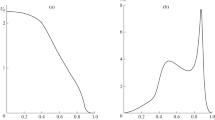Abstract
The possibility of initiating detonation in a closed field due to motion of its boundaries for a one-step kinetic model is studied by numerical simulation of the problems of flow of a propane-air mixture inside and outside a rotating elliptic cylinder enclosed in a circular cylinder; in rotation of a circular cylinder with parabolic blades uniformly distributed along its boundary, or in rotation of a star-shaped figure with parabolic rays originating from the center of rotation; and in a plane chamber with deformable walls. Critical parameter values for which detonation occurs are determined. A method of approximate description of the processes occurring in three-dimensional helical channels is considered. In the numerical study of these processes, software based on the Godunov scheme was used.
Similar content being viewed by others
References
V. A. Levin, V. V. Markov, S. F. Osinkin, and T. A. Zhuravskaya, “Determination of critical conditions for detonation initiation in a finite volume by a converging shock wave,” Combust., Expl., Shock Waves, 38, No. 6, 693–699 (2002).
T. A. Zhuravskaya, V. A. Levin, V. V. Markov, and S. F. Osinkin, “Effect of a collapsing shell on detonation formation in a finite volume by a converging shock wave,” Khim. Fiz., 22, No. 8, 34–37 (2003).
I. V. Semenov, P. S. Utkin, and V. V. Markov, “Numerical simulation of two-dimensional detonation flows on a multiprocessor computer,” Vychisl. Met. Program., 9, No. 1, 123–132 (2008).
I. V. Semenov, P. S. Utkin, and V. V. Markov, “Numerical simulation of detonation initiation in a contoured tube,” Combust., Expl., Shock Waves, 45, No. 6, 700–707 (2009).
A. A. Il’yushin, “Law of plane sections in the aerodynamics of high hypersonic velocities,” Prikl. Mat. Mekh., 20, No. 6, 733–755 (1956).
G. G. Chernyi, High Hypersonic Velocity Gas Flows [in Russian], Moscow, Fizmatgiz (1959).
V. A. Levin, V. V. Markov, and S. F. Osinkin, “Initiation of detonation by a piston in a hydrogen-air mixture,” Dokl. Akad. Nauk SSSR, 258, No. 2, 288–291 (1981).
C. K. Westbrook and F. L. Dryer, “Chemical kinetic modeling of hydrocarbon combustion,” Progr. Energ. Combust. Sci., 10, 1–57 (1984).
S. K. Godunov, A. V. Zabrodin, M. Ya. Ivanov, A. N. Kraiko, and G. P. Prokopov, Numerical Solution of Multidimensional Problems of Gas Dynamics [in Russian], Nauka, Moscow (1976).
V. V. Markov, “Numerical simulation of the formation of the multifront structure of a detonation wave,” Dokl. Akad. Nauk SSSR, 258, No. 2, 314–317 (1981).
L. I. Sedov, V. P. Korobeinikov, and V. V. Markov, “Theory of shock-wave propagation,” Tr. Mat. Inst., 175, 178–216 (1988).
V. A. Levin, V. V. Markov, and S. F. Osinkin “Direct initiation of detonation in a hydrogen-oxygen mixture diluted with nitrogen,” Izv. Akad. Nauk SSSR, Mekh. Zhidk. Gaza, No. 6, 151–156 (1992).
V. A. Levin, V. V. Markov, and S. F. Osinkin “Detonation initiation in a hydrogen-air mixture by explosion of a spherical TNT charge,” Combust., Expl., Shock Waves., 31, No. 2, 207–210 (1995).
V. A. Levin, V. V. Markov, and S. F. Osinkin “Restoration of detonation by means of a collapsing shell,” Dokl. Akad. Nauk, 352, No. 1, 333–335 (1997).
T. A. Zhuravskaya, V. A. Levin, V. V. Markov, and S. F. Osinkin, “Calculation of initiation of gaseous detonation by an electrical discharge,” Khim. Fiz., 23, No. 9, 52–55 (2004).
V. A. Levin, V. V. Markov, T. A. Zhuravskaya, and S. F. Osinkin “Nonlinear wave processes during initiation and propagation of gaseous detonation,” Tr. Mat. Inst., 251, 200–214 (2005).
V. A. Levin, I. S. Manuilovich, and V. V. Markov, “New effects of layered gaseous detonation,” Dokl. Ross. Akad. Nauk, 430, No. 2, 35–43 (2010).
Author information
Authors and Affiliations
Corresponding author
Additional information
__________
Translated from Prikladnaya Mekhanika i Tekhnicheskaya Fizika, Vol. 51, No. 4, pp. 17–25, July–August, 2010.
Rights and permissions
About this article
Cite this article
Levin, V.A., Manuilovich, I.S. & Markov, V.V. Detonation initiation by rotation of an elliptic cylinder inside a circular cylinder and deformation of the channel walls. J Appl Mech Tech Phy 51, 463–470 (2010). https://doi.org/10.1007/s10808-010-0062-6
Received:
Published:
Issue Date:
DOI: https://doi.org/10.1007/s10808-010-0062-6



